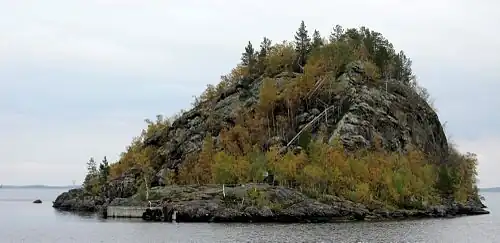Ukko (island)

Ukko (Inari Sami: Äijih)[1][2][a] is an island in Lake Inari, Finnish Lapland. The area of the lake is called Ukonselkä. Ukko was considered by the local Inari Sámi to be an extremely important sieidi (Inari Sami: siejdi, Finnish: seita), or sacred natural formation, and was used as a sacrificial site, perhaps as recently as in the 19th century.[3] The names "Ukko" and "Äijih" refer to sky deities in the Finnish and Sámi mythologies, respectively.
The island is about 30 metres (98 feet) high, 50 metres (160 feet) broad and a 100 metres (330 feet) long. The distance from the village of Inari to Ukko is approximately 11 kilometres (6.8 miles). There are guided tours to the site during the summer from the harbour of the Sámi museum, Siida.
There are two known siedis at Ukonsaari. The first one to be studied was a sacrificial cave. One of the most important archaeological findings in Lapland was made at Ukko in 1873 by the British archaeologist Sir Arthur Evans, when a silver jewellery fragment was found in the cave. An additional siedi was discovered in 2007 by Finnish archaeologists.[3]
The names of some of the numerous islands adjacent to Ukonsaari may suggest other religious sites, for example:
- Palo Ukko (Finnish: Fire-Ukko)
- Pikku Ukko (Little Ukko)
- Ukonkarit (Ukko's skerries, a series of islets close to Ukonsaari)
- Hautuumaasaari (Burial ground island)
- Aviosaaret (Marriage islands)
- Tissikivisaari (Breast-stone island)
- Junttisaari (Juntti is a complex word approximately meaning a yokel or hillbilly.[4])
- Vanha hautuumaasaari (Old burial ground island)
- Ristisalmensaaret (Cross sound islands)
See also
Notes
- ^ Also known as Ukonsaari or Ukonkivi (Finnish), Äijihsuálui or Äijihkeđgi (Inari Sámi); Northern Sami: Ádjásuolu[2]
References
- ^ "Ukko". Information cards for geographic names. National Land Survey of Finland. 2016-06-30. Retrieved 2025-08-08.
- ^ a b Paikkala, Sirkka; et al. (2007). Suomalainen paikannimikirja (PDF) (digital version) (in Finnish). Helsinki: Institute for the Languages of Finland (Kotus). p. 476. ISBN 978-952-5446-96-8. Retrieved 2025-08-08.
- ^ a b "HS: Saamelaisten pyhät paikat herättävät uutta mielenkiintoa". Originally published in Helsingin Sanomat. Archived from the original on 2015-11-18.
- ^ "Finnish word juntti". Archived from the original on 2025-03-24. Retrieved 2020-01-17.
Further reading
- "Ukonsaari". nationalparks.fi. Metsähallitus. Retrieved 9 November 2016. (Dead link, March 1st, 2021)
- Some archeological sites of Finland Archived 2011-07-16 at the Wayback Machine(Dead link, March 1st, 2021)
- Picture of Ukonsaari Archived 2011-02-01 at the Wayback Machine(Dead link, March 1st, 2021)
68°56′19.6″N 27°17′32.3″E / 68.938778°N 27.292306°E